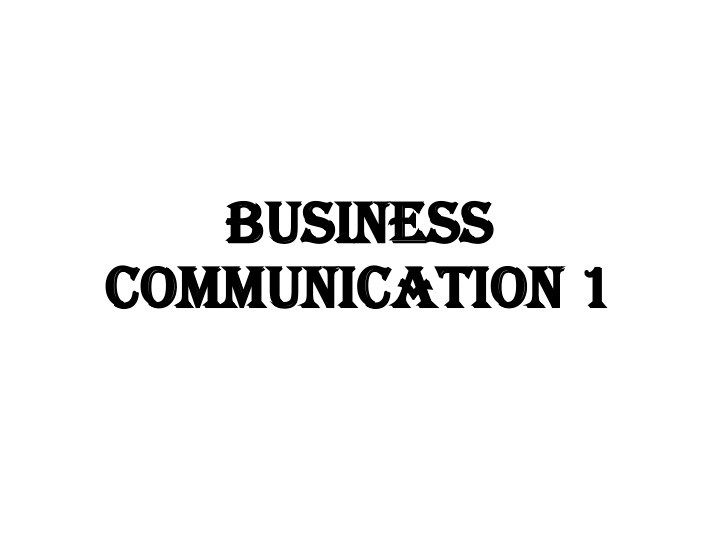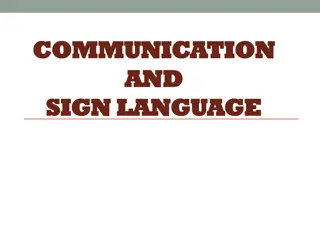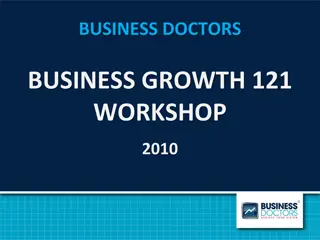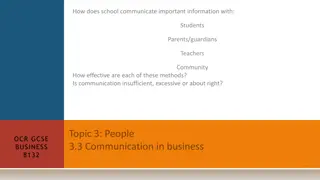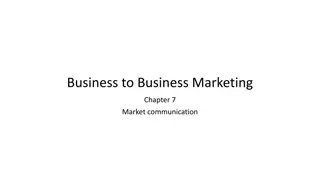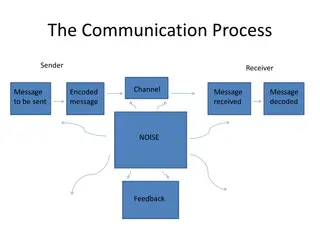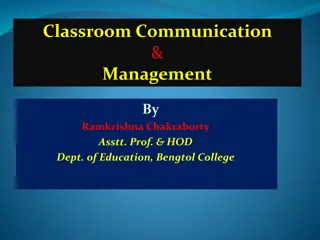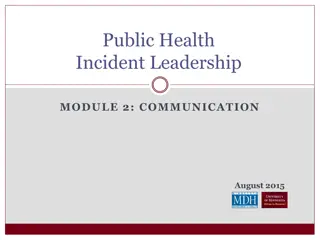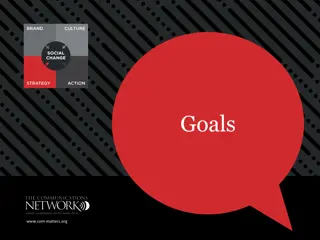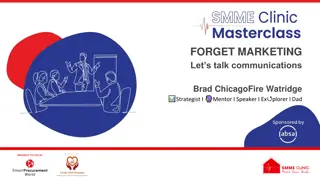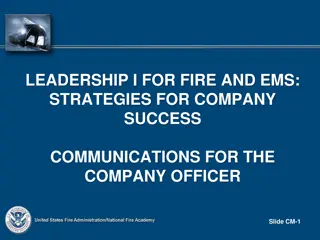Business Communication Strategies for Success
Developing effective communication skills in the business world is crucial for success. This requires honing both verbal and written communication techniques, as well as understanding how to navigate complex interpersonal dynamics. By adopting clear and concise communication practices, businesses can enhance collaboration, improve productivity, and foster strong relationships with clients and partners. This article explores the key strategies and practical tips to elevate your business communication game.
Download Presentation

Please find below an Image/Link to download the presentation.
The content on the website is provided AS IS for your information and personal use only. It may not be sold, licensed, or shared on other websites without obtaining consent from the author.If you encounter any issues during the download, it is possible that the publisher has removed the file from their server.
You are allowed to download the files provided on this website for personal or commercial use, subject to the condition that they are used lawfully. All files are the property of their respective owners.
The content on the website is provided AS IS for your information and personal use only. It may not be sold, licensed, or shared on other websites without obtaining consent from the author.
E N D
Presentation Transcript
BUSINESS BUSINESS COMMUNICATION 1 COMMUNICATION 1
Definition:- The act of sharing or exchanging information, ideas or feelings. Communication is the act of conveying meanings from one entity or group to another through the use of mutually understood signs, symbols, and semiotic rules.
Process of Communication Process of Communication
Definition Sender- has an idea and sends the message Encoding - converting the idea into a message Message- idea / content / information Medium - mode through which message is transmitted Receiver - the one who receives the message. Decoding - understanding thethe message. Feedback - reply.
NEED FOR COMMUNICATION Why do you need to communicate?
Positive Feedback vs Negative Feedback Formal Feedback vs Informal Feedback Peer Feedback vs Self Feedback Written Feedback vs Oral Feedback
CHANNELS AND OBJECTIVES OF COMMUNICATION
Formal Channel Horizontal Vertical Upward Downward
Downward Communication Downward Communication is the Communication that flows from the superior to the subordinates. Advantages Disadvantages It ensures discipline. Efficient functioning There's clarity & no confusion. Delay Distortion Loss of information Lack of accountability Absence of feedback.
Upward Communication Upward Communication Upward communication is needed to forward employee-feedback to report on official matters to give voice to the difficulties, grievances, dissatisfaction and work-related demands of employees to invite suggestions, creativity and participation in problem solving to create a sense of belonging through participation
Upward Communication Upward Communication Advantages Disadvantages Feedback Development of trust and positive bonding. Part of decision making process. Eliminates misunderstanding Fails, if there's no subordinate initiative. Delay Distortion Looses trust if feedback not taken seriously.
Horizontal Communication Horizontal Communication Horizontal communication is communication that takes place between employees belonging to the same or comparable status. Communication between two marketing managers, or between two directors, is horizontal communication. It is an interaction between members belonging to the same level of authority or hierarchy.
Horizontal communication Horizontal communication Advantages Clarifying doubts Eliminate misunderstanding Better coordination Builds team spirit Disadvantages Sometimes disrupts vertical channel Wastage of time Irrelevant communication
Diagonal Communication Diagonal Communication It is a semi formal channel communication. It is cross departmental communication. It is communication that takes place between people belong to the different level of authority. It is the communication that takes place outside their reporting relationship. It is partially formal partially informal.
Diagonal Communication Diagonal Communication Advantages Disadvantages speeds up the flow of information creates healthy work relationships brings in proper co-ordination among different sections makes problem-solving easy controls distortion and dilution of message because of direct,inter-level communication. It may be seen as interference Breaks the line of authority. Leads to chaos and confusion.
Informal Communication Informal Communication People need to share and agree on important opinions and attitudes to feel that they belong to a group. Hence, much information is exchanged unofficially within an organization and among members of subgroups, which satisfies the need to conform and to share positions on various issues People need to share their hopes and ambitions with superiors People need to express emotions such as joy, anger, hostility, and the like as a means of blowing off steam.
Grapevine Communication Grapevine Communication This is personal communication which is transmitted between individuals or groups and comprises personal interpretations, opinions, gossip, reactions, hearsay, half-truths. It is an unofficial circulation that makes the rounds in an organisation and, though it lacks credence, the receiver finds it hard to resist. Since, more often than not, negative information, half- truths, personalized accounts of events, gross distortions are passed on by the sender and taken as true by the receiver.
How does management How does management tackle the grapevine? tackle the grapevine?
Grapevine Communication Grapevine Communication Managements must be fully aware about the potential power of the grapevine. This can often fail formal communication, as it is difficult to trace its origin and is difficult to control or stop completely. Therefore, management must circulate information that is accurate and strengthen upward channels of communication
Grapevine Communication Grapevine Communication To avoid unnecessary grapevine, the organisation must take prompt note of communication from employees. Moreover, if employees feel confident about the management, instances of grapevine will reduce. Management, therefore, must delegate responsibility and entrust employees with specific responsibilities to strengthen trust between itself and its employees. Some measures to control the grapevine are inviting suggestions, forming grievance and redressal cells.
Objectives of Objectives of Communication Communication
Objectives Objectives Information Advice/ counselling Order and Instructions Suggestions Persuasion Education Motivation Raising employees morale Warning
Methods and Modes of Communication
Principles of oral communication Know your objective Know your subject Know your audience Know how to use voice Know when to stop.
Advantages and disadvantages of oral communication Direct & Time saving Saves money Convey the exact meaning of the words. Immediate feedback Persuasive in nature Confidential messages can be shared Friendly and informal Lacks legal validity Lacks accountability Possibility of misunderstanding Lack of retention Not always effective Requires strong communication skills.
Written Communication Written Communication Advantages Permanent record Legal validity Better retention Accurate Fixing responsibility Wider reach Disadvantages Time, trouble & expensive Feedback is slow Formal Not suited in countries where there's illiteracy
Non Verbal communication Non Verbal communication Kinesics or Body Language Posture Gesture Dress and Grooming Facial Expressions Proxemics Paralanguage Silence Visual and Auditory Signs and symbols Posters, Colours, Maps,Graphs and Charts
Modes of Modes of Communication Communication
Telephone Telephone Advantages Disadvantages Saves time. Comfortable Immediate feedback Personal and informal. Sometimes inconvenient No legal validity Non Verbal communication are not communicated. Wrong time.
Uses of internet Uses of internet Information Enables teaching learning & Research Online Shopping E-Transaction Entertainment Social Media GPS Communication Work From home Innovation Globalization E-Trading Saves time Online Ticket Booking / Reservation Job Hunting
Disadvantages of Internet Disadvantages of Internet Cyber crime Hacking. Wastage of time. Addictive Cyber bullying Stalking Trolling Rumors Lazy Health issues Spam / fraud Affects our concentration & focus Not safe for children Information not reliable Social isolation
CONTEMPORARY METHODS CONTEMPORARY METHODS Audio Conferencing Video Conferencing
Revision Revision
Chapter 4 Chapter 4
Barriers to Communication Barriers to Communication
Physical / Environmental Barrier Physical / Environmental Barrier Noise Wrong selection of medium Climate Time Place
Semantic Barrier Semantic Barrier Language Barrier can be of 4 major types Semantic, syntactic, phonological & linguistic. Misinterpretation of words. Difference in language Use of Jargon Similar sounding words.
Psychological Barrier Psychological Barrier Emotions Prejudice Halo & Horn effect Different Perception Closed mind Inattentiveness Rambling Impatience Selective listening Distraction
Cultural Barrier Cultural Barrier Time Food Clothing Space & Proximity Non Verbal cues Etiquette & Mannerisms
